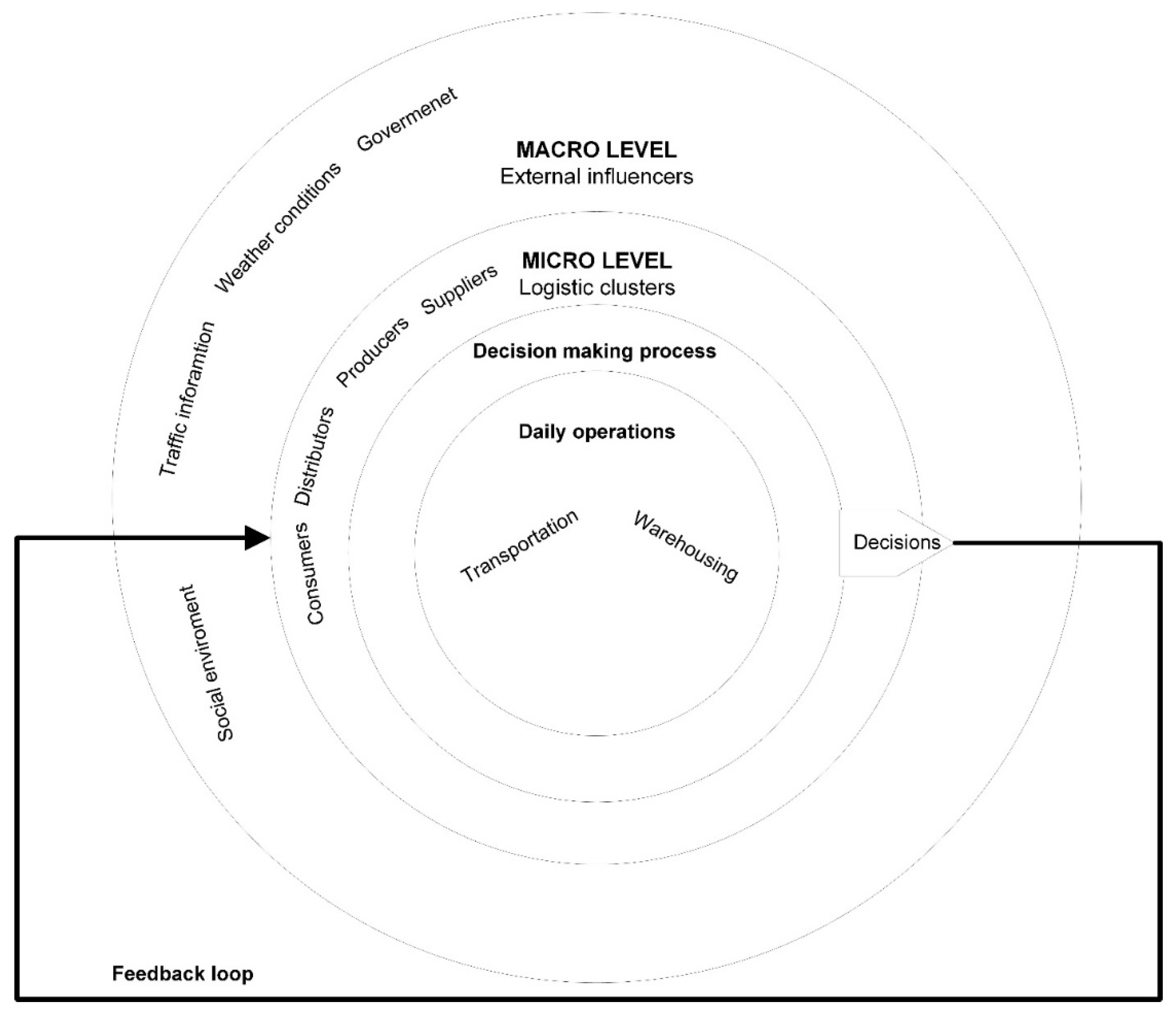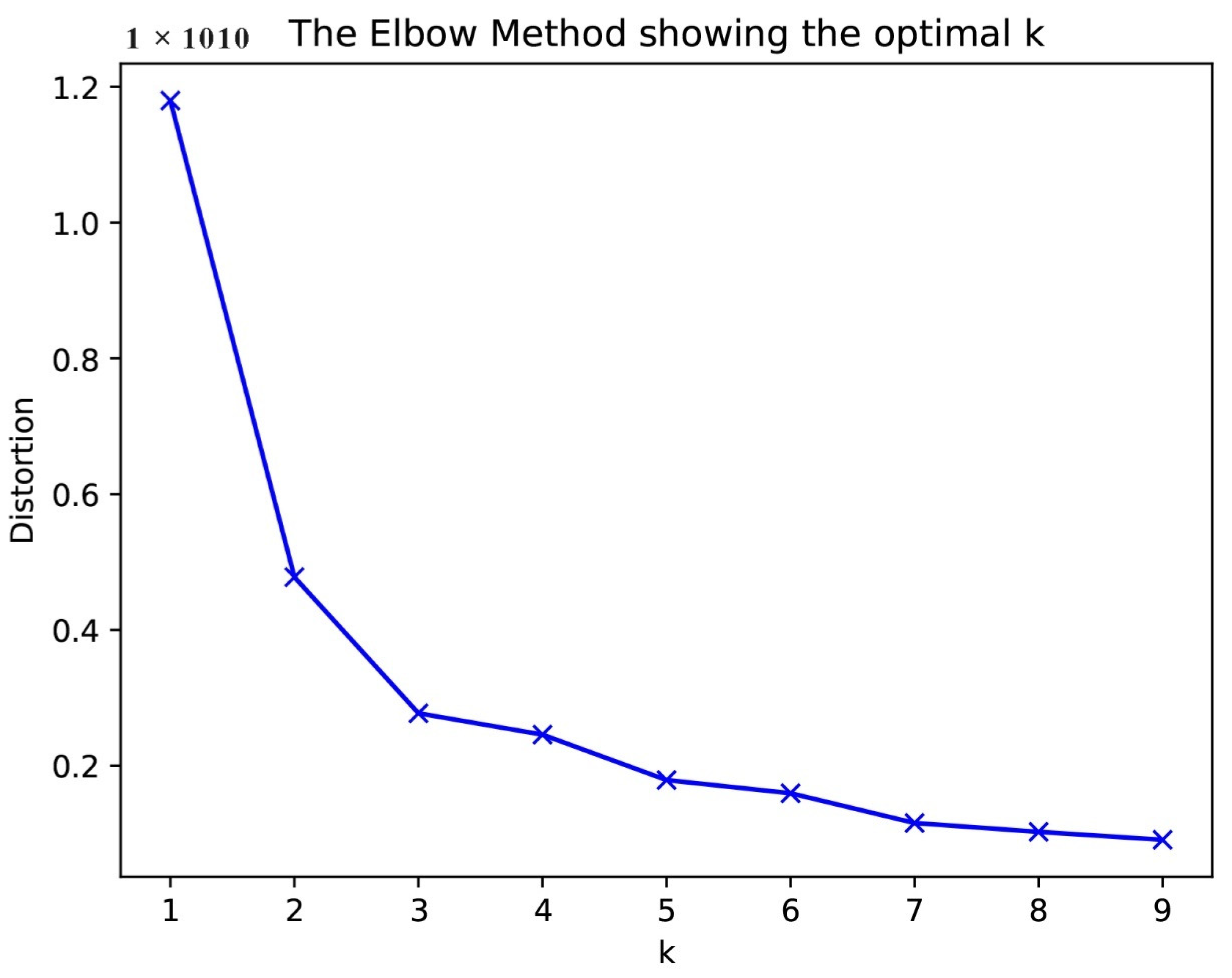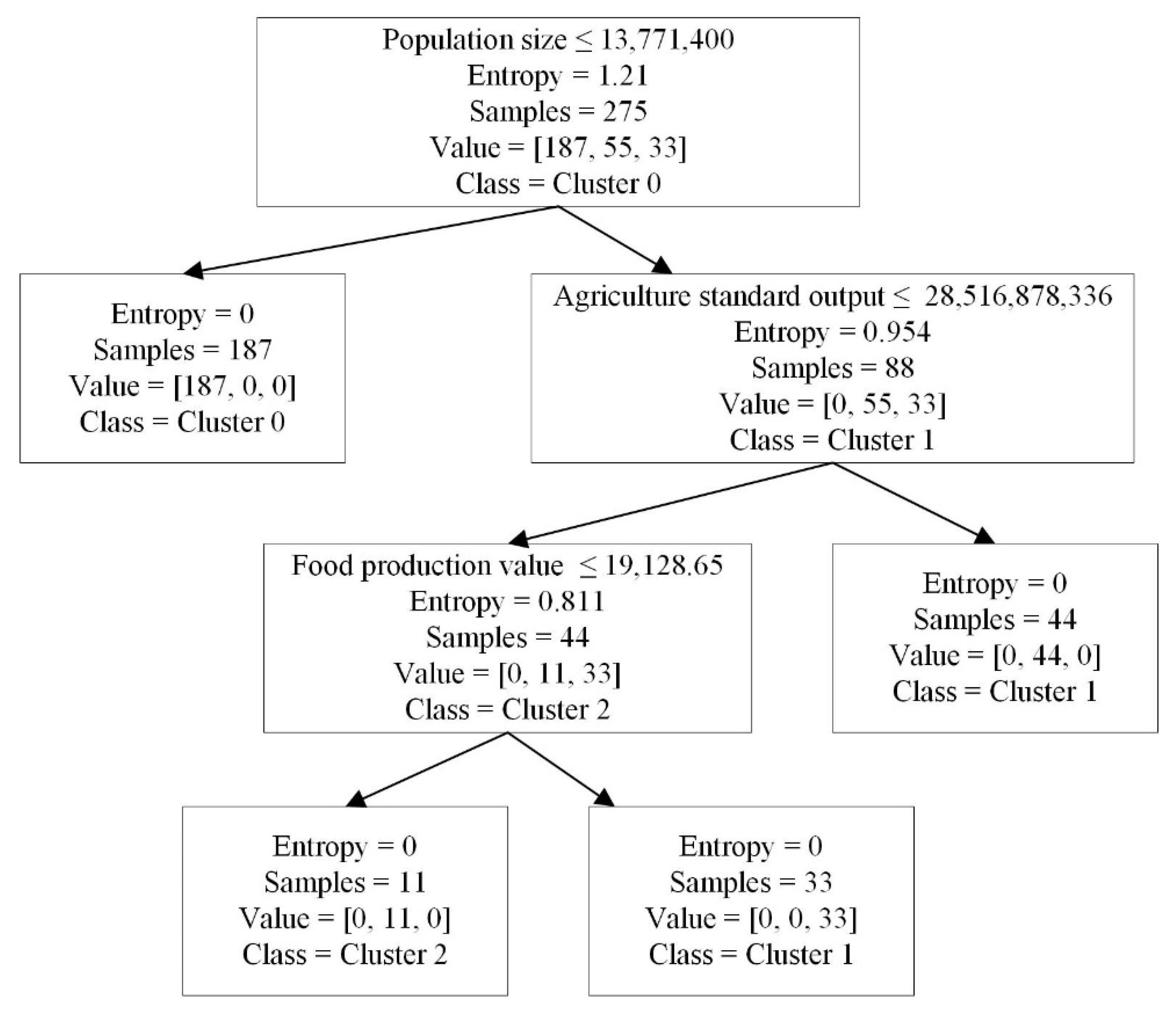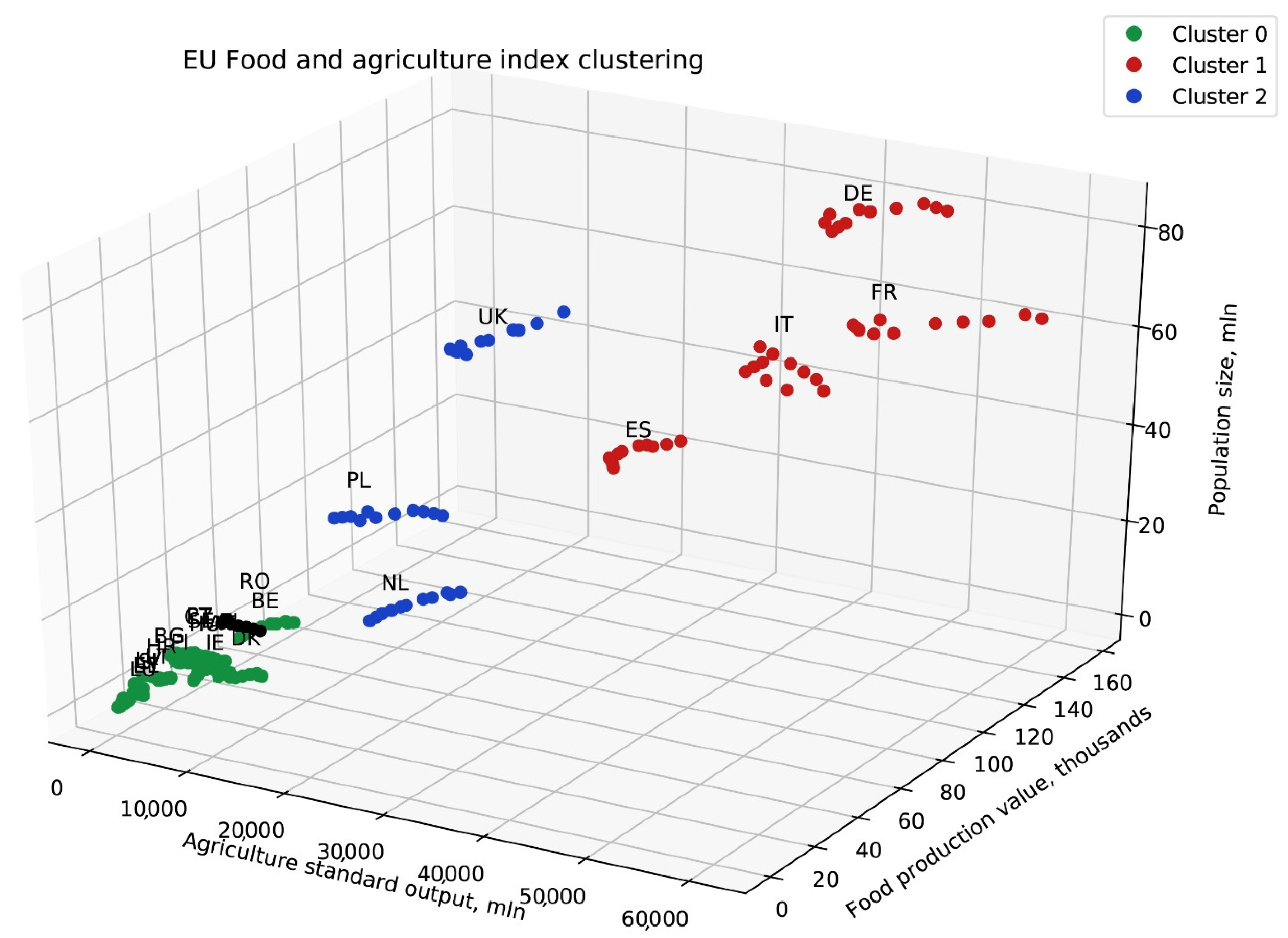Managing Supply Chain Complexity and Sustainability: The Case of the Food Industry
Abstract
:1. Introduction
2. Literature Analysis
2.1. Supply Chain Strategies for Sustainable Development
2.2. Complexity Theory Adaptation for Supply Chain Management
3. Contingencies Determination of the Food Industry
3.1. Contingencies of the Food Industry
3.2. Methodology
3.3. Macro Index Analysis of the Food Industry
4. Discussion
5. Conclusions
Author Contributions
Funding
Institutional Review Board Statement
Informed Consent Statement
Data Availability Statement
Conflicts of Interest
References
- Food and Agriculture Organization. The Future of Food and Agriculture: Trends and Challenges. Available online: https://www.fao.org/3/i6583e/i6583e.pdf (accessed on 20 January 2022).
- Council of the European Union. Food Losses and Food Waste. Available online: https://www.fao.org/food-loss-and-food-waste/flw-data (accessed on 20 January 2022).
- DHL Logistics Trend Radar. Available online: https://www.dhl.com/lt-en/home/insights-and-innovation/insights/logistics-trend-radar.html (accessed on 20 January 2022).
- Kayikci, Y. E-Commerce in Logistics and Supply Chain Management. In Encyclopedia of Information Science and Technology; IGI Global: Hershey, PA, USA, 2017; pp. 1015–1026. [Google Scholar]
- Alcantara, P.; Riglietti, G.; Aguada, L.; BCI. Supply Chain Resilience Report. Available online: https://www.thebci.org/static/e02a3e5f-82e5-4ff1-b8bc61de9657e9c8/BCI-0007h-Supply-Chain-Resilience-ReportLow-Singles.pdf (accessed on 20 January 2022).
- Pires Ribeiro, J.; Barbosa-Povoa, A. Supply Chain Resilience: Definitions and quantitative modelling approaches—A literature review. Comput. Ind. Eng. 2017, 115, 109–122. [Google Scholar] [CrossRef]
- Christopher, M.; Holweg, M. Supply Chain 2.0′: Managing supply chains in the era of turbulence. Int. J. Phys. Distrib. Logist. Manag. 2011, 41, 63–82. [Google Scholar] [CrossRef]
- Navickas, V.; Kuznetsova, S.A.; Gruzauskas, V. Cyber–physical systems expression in industry 4.0 context. Financ. Credit Act. Probl. Theory Pract. 2017, 2, 188–197. [Google Scholar] [CrossRef] [Green Version]
- Palmberg, K. Complex adaptive systems as metaphors for organizational management. Learn. Organ. 2009, 16, 483–498. [Google Scholar] [CrossRef] [Green Version]
- Gružauskas, V.; Vojtovic, S.; Navickas, V. Cyber-physical systems impact to supply chain competitiveness. In Proceeding of the CITPM Conference on Contemporary Issues in Theory and Practice of Management, Czestochowa, Poland, 19–20 April 2018; p. 117. [Google Scholar]
- Kamalahmadi, M.; Parast, M.M. A review of the literature on the principles of enterprise and supply chain resilience: Major findings and directions for future research. Int. J. Prod. Econ. 2016, 171, 116–133. [Google Scholar] [CrossRef]
- Chowdhury, M.M.H.; Quaddus, M. Supply chain resilience: Conceptualization and scale development using dynamic capability theory. Int. J. Prod. Econ. 2017, 188, 185–204. [Google Scholar] [CrossRef]
- Gunasekaran, A.; Subramanian, N.; Rahman, S. Supply chain resilience: Role of complexities and strategies. Int. J. Prod. Res. 2015, 53, 6809–6819. [Google Scholar] [CrossRef] [Green Version]
- Ding, Y.; Jin, M.; Li, S.; Feng, D. Smart logistics based on the internet of things technology: An overview. Int. J. Logist. Res. Appl. 2021, 24, 323–345. [Google Scholar] [CrossRef]
- Angkiriwang, R.; Pujawan, I.N.; Santosa, B. Managing uncertainty through supply chain flexibility: Reactive vs. proactive approaches. Prod. Manuf. Res. 2014, 2, 50–70. [Google Scholar] [CrossRef] [Green Version]
- Vlajic, J. Effective Usage of Redundancy And Flexibility in Resilient Supply Chains. In Proceedings of the International Symposium on Logistics: Data Driven Supply Chains, Ljubljana, Slovenia, 9–12 July 2017; pp. 450–458. [Google Scholar]
- Hwang, Y.-M.; Rho, J.-J. Strategic value of RFID for inter-firm supply chain networks. Inf. Dev. 2016, 32, 509–526. [Google Scholar] [CrossRef]
- Pettit, T.J.; Croxton, K.L.; Fiksel, J. Ensuring Supply Chain Resilience: Development and Implementation of an Assessment Tool Ensuring. J. Bus. Logist. 2016, 34, 46–76. [Google Scholar] [CrossRef]
- Arvitrida, N.I.; Robinson, S.; Tako, A.A.; Robertson, D.A. An agent-based model of supply chain collaboration: Investigating manufacturer loyalty. In Proceedings of the Operational Research Society Simulation Workshop 2016, Ettington, UK, 11–13 April 2016; pp. 35–44. [Google Scholar]
- Herczeg, G.; Akkerman, R.; Hauschild, M.Z. Supply chain collaboration in industrial symbiosis networks. J. Clean. Prod. 2018, 171, 1058–1067. [Google Scholar] [CrossRef]
- Boyes, H.; Hallaq, B.; Cunningham, J.; Watson, T. The industrial internet of things (IIoT): An analysis framework. Comput. Ind. 2018, 101, 1–12. [Google Scholar] [CrossRef]
- Adams, F.G.; Richey, R.G.; Autry, C.W.; Morgan, T.R.; Gabler, C.B. Supply chain collaboration, integration, and relational technology: How complex operant resources increase performance outcomes. J. Bus. Logist. 2014, 35, 299–317. [Google Scholar] [CrossRef]
- Azadegan, A.; Jayaram, J. Resiliency in Supply Chain Systems: A Triadic Framework Using Family Resilience Model. In Supply Chain Risk Management; Springer: Singapore, 2018; pp. 269–288. ISBN 9781482205978. [Google Scholar]
- Sáenz, M.J.; Revilla, E.; Acero, B. Aligning supply chain design for boosting resilience. Bus. Horiz. 2018, 61, 443–452. [Google Scholar] [CrossRef]
- Verdouw, C.N.; Wolfert, J.; Beulens, A.J.M.; Rialland, A. Virtualization of food supply chains with the internet of things. J. Food Eng. 2016, 176, 128–136. [Google Scholar] [CrossRef] [Green Version]
- Navickas, V.; Gružauskas, V. Big data concept in the food supply chain: Small markets case. Sci. Ann. Econ. Bus. 2016, 63, 15–28. [Google Scholar] [CrossRef] [Green Version]
- Gružauskas, V.; Baskutis, S.; Navickas, V. Minimizing the trade-off between sustainability and cost effective performance by using autonomous vehicles. J. Clean. Prod. 2018, 184, 709–717. [Google Scholar] [CrossRef]
- Smetana, S.; Aganovic, K.; Heinz, V. Food Supply Chains as Cyber-Physical Systems: A Path for More Sustainable Personalized Nutrition. Food Eng. Rev. 2021, 13, 92–103. [Google Scholar] [CrossRef]
- Arthur, W.B. Complexity Economics: A Different Framework for Economic Thought. Complex. Econ. 2013, 43, 1–22. [Google Scholar]
- Davis, J.P.; Eisenhardt, K.M.; Bingham, C.B. Developing Theory Through Simulation Methods. Acad. Manag. Rev. 2007, 32, 480–499. [Google Scholar] [CrossRef] [Green Version]
- Benthall, S. Philosophy of Computational Social Science. Cosm. Hist. J. Nat. Soc. Philos. 2016, 12, 13–30. [Google Scholar]
- Caspersen, E.; Navrud, S. The sharing economy and consumer preferences for environmentally sustainable last mile deliveries. Transp. Res. Part D Transp. Environ. 2021, 95, 102863. [Google Scholar] [CrossRef]
- Trochim, W.M.K. Deduction & Induction. Research Methods Knowledge Base. 2022. Available online: https://conjointly.com/kb/deduction-and-induction/ (accessed on 20 January 2022).
- Axelrod, R. Advancing the art of simulation in the social sciences-SSP. J. Jpn. Int. Econ. 2005, 12, 16–22. [Google Scholar]
- Wollmann, D.; Steiner, M.T.A. The strategic decision-making as a complex adaptive system: A conceptual scientific model. Complexity 2017, 1, 7954289. [Google Scholar] [CrossRef] [Green Version]
- Wycisk, C.; McKelvey, B.; Hülsmann, M. Smart parts’ supply networks as complex adaptive systems: Analysis and implications. Int. J. Phys. Distrib. Logist. Manag. 2008, 38, 108–125. [Google Scholar] [CrossRef] [Green Version]
- Cordes, P.; Hülsmann, M. Self-healing Supply Networks: A Complex. In Supply Chain Safe Management; Springer: Berlin/Heidelberg, Germany, 2013; pp. 217–230. ISBN 9783642446740. [Google Scholar]
- Marchi, J.J.; Erdmann, R.H.; Rodriguez, C.M.T.; Marchi, J.J.; Erdmann, R.H.; Rodriguez, C.M.T. Understanding Supply Networks from Complex Adaptive Systems. BAR-Braz. Adm. Rev. 2014, 11, 441–454. [Google Scholar] [CrossRef] [Green Version]
- Chriss, N.; Ginzburg, V. Representation Theory and Complex Geometry; Birkhäuser: Boston, MA, USA, 1997. [Google Scholar]
- Chaouni, C.; Benabdellah, A.; Bouhaddou, I.; Benghabrit, A. Supply chain challenges with complex adaptive system perspective. In Proceedings of the World Conference on Information Systems and Technologies, Azores, Portugal, 2 April 2018; pp. 1081–1093. [Google Scholar]
- Aelker, J.; Bauernhansl, T.; Ehm, H. Managing complexity in supply chains: A discussion of current approaches on the example of the semiconductor industry. Procedia CIRP 2013, 7, 79–84. [Google Scholar] [CrossRef]
- Barrientos, A.H.; Idalia Flores, M. Modeling Sustainable Supply Chain Management as a Complex Adaptive System: The Emergence of Cooperation. In Sustainable Supply Chain Management; IntechOpen: London, UK, 2016; pp. 195–218. ISBN 9781848215269. [Google Scholar]
- Euromonitor. International, Fresh Food Global Industry Overview. Available online: https://www.euromonitor.com/fresh-food-global-industry-overview/report (accessed on 20 January 2022).
- Food and Agriculture Organization. How to Feed the World in 2050. Available online: https://www.fao.org/fileadmin/templates/wsfs/docs/expert_paper/How_to_Feed_the_World_in_2050.pdf (accessed on 20 January 2022).
- Siyodia, R.; Yelamanchili, R. Challenges and Constraint in Supply Chain Management for Hyperlocal Delivery Business in India. In Proceedings of the SIMSR Global Supply Chain Management Conference, Mumbai, India, 16 December 2016; pp. 1–10. [Google Scholar]
- EU Fusions. Estimates of European Food Waste Levels. Available online: https://www.eu-fusions.org/phocadownload/Publications/Estimates%20of%20European%20food%20waste%20levels.pdf (accessed on 20 January 2022).
- Borrello, M.; Caracciolo, F.; Lombardi, A.; Pascucci, S.; Cembalo, L. Consumers’ perspective on circular economy strategy for reducing food waste. Sustainability 2017, 9, 141. [Google Scholar] [CrossRef] [Green Version]
- Saskia, S.; Mareï, N.; Blanquart, C. Innovations in e-grocery and Logistics Solutions for Cities. Transp. Res. Procedia 2015, 12, 825–835. [Google Scholar] [CrossRef]
- Wägeli, S.; Hamm, U. Consumers’ perception and expectations of local organic food supply chains. Org. Agric. 2016, 6, 215–224. [Google Scholar] [CrossRef]
- Willer, H.; Lernoud, J. The World of Organic Agriculture 2016: Statistics and Emerging Trends. Available online: https://orgprints.org/id/eprint/34570 (accessed on 20 January 2022).
- Dovleac, L. An overview on the supply chain for European organic food market. Bull. Transilv. Univ. Brasov. Ser. V Econ. Sci. 2016, 9, 325–330. [Google Scholar]
- FIBL. European Organic Market Survey. 2018. Available online: http://www.fibl.org/en/service-en/news-archive/news/article/european-organic-market-grew-by-double-digits-and-organic-area-reached-135-million-hectares-in-2016.html (accessed on 20 January 2022).
- Eurostat. Industry by Employment Size Class. Available online: http://appsso.eurostat.ec.europa.eu/nui/show.do?dataset=sbs_sc_ind_r2&lang=en (accessed on 20 January 2022).
- Eurostat. Population Density by NUTS 3 Region. Available online: http://appsso.eurostat.ec.europa.eu/nui/show.do?dataset=demo_r_d3dens&lang=en (accessed on 20 January 2022).
- Eurostat. Distribution of Population by Degree of Urbanisation. Available online: http://appsso.eurostat.ec.europa.eu/nui/show.do?dataset=ilc_lvho01&lang=en (accessed on 20 January 2022).
- Taylor, S.J.; Letham, B. Forecasting at Scale. Am. Stat. 2018, 72, 37–45. [Google Scholar] [CrossRef]
- Varian, H.R. Big Data: New Tricks for Econometrics. Am. Econ. Assoc. 2014, 28, 3–27. [Google Scholar] [CrossRef] [Green Version]
- Thesling, P. Machine Learning and Econometrics. Master’s Thesis, Maastricht University, Maastricht, The Netherlands, August 2015. [Google Scholar] [CrossRef]
- Einav, L.; Levin, J.D. The Data Revolution and Economic Analysis. NBER Work. Pap. 2013, 53, 1689–1699. [Google Scholar]
- Mullainathan, S.; Spiess, J. Machine Learning: An Applied Econometric Approach. J. Econ. Perspect. 2017, 31, 87–106. [Google Scholar] [CrossRef] [Green Version]
- Liu, Y.; Xie, T. Machine learning versus econometrics: Prediction of box office. Appl. Econ. Lett. 2019, 26, 124–130. [Google Scholar] [CrossRef]
- Řezanková, H. Cluster Analysis of Economic Data. Stat. Stat. Econ. J. 2014, 94, 73–86. [Google Scholar]
- Kembe, M.M. Statistics and Mathematical Sciences Cluster Analysis of Macroeconomic Indices. Res. Rev. J. Stat. Math. Sci. 2017, 3, 5–15. [Google Scholar]
- Augustyński, I.; Laskoś-Grabowski, P.P. Clustering Macroeconomic Time Series. Econom. Adv. Appl. Data Anal. 2018, 22, 74–88. [Google Scholar]
- Punma, C. Autonomous Vehicle Fleet Coordination With Deep Reinforcement Learning. In Proceedings of the ICLR International Conference on Learning Representations, Vancouver, BC, Canada, 30 April–3 May 2018; pp. 1–8. [Google Scholar]
- Sánchez, N.C.; Martinez, I.; Pastor, L.A.; Larson, K. Simulation study on the fleet performance of shared autonomous bicycles. arXiv 2021, arXiv:2106.09694. [Google Scholar]
- Nazari, M.; Oroojlooy, A.; Snyder, L.V.; Takáč, M. Deep Reinforcement Learning for Solving the Vehicle Routing Problem. Adv. Neural Inf. Process. Syst. 2018, 2, 1–13. [Google Scholar]
- Gružauskas, V.; Čalnerytė, D.; Fyleris, T.; Kriščiūnas, A. Application of multivariate time series cluster analysis to regional socioeconomic indicators of municipalities. Real Estate Manag. Valuat. 2021, 29, 39–51. [Google Scholar] [CrossRef]







| Characteristic | Expression |
|---|---|
| Distributed control | Supply chain members does not have a centralized control unit |
| Inter-dependent agents | Supply chain members has multiple inter-dependent interactions between themselves |
| Non-linearity | Interactions between the supply chain members produces non-linier results i.e., chaotic |
| Not predictable in detail | Constant disruptions causes the supply chain members to work in an unstable environment |
| Adaptability | Supply chain member learns from experience and improves their operations constantly |
| Self-organization | Supply chain members without central control forms patterns and order |
| Emergence | Interactions between supply chain members causes macro level outcome |
| Cluster ID | Count | Mean | STD | Min | Max | Indicator |
|---|---|---|---|---|---|---|
| 0 | 187 | 99.58 | 79.55 | 17.20 | 371.80 | Density |
| 1 | 55 | 142.55 | 59.75 | 86.10 | 230.90 | |
| 2 | 33 | 291.40 | 154.88 | 121.90 | 502.90 | |
| 0 | 187 | 35.94 | 9.20 | 13.00 | 54.30 | Distribution Cities |
| 1 | 55 | 43.95 | 6.19 | 31.90 | 51.90 | |
| 2 | 33 | 53.25 | 13.75 | 32.50 | 76.80 | |
| 0 | 187 | 41.45 | 13.21 | 4.00 | 66.60 | Distribution Rural areas |
| 1 | 55 | 28.64 | 16.06 | 14.70 | 70.63 | |
| 2 | 33 | 21.11 | 17.60 | 1.90 | 46.70 | |
| 0 | 187 | 22.62 | 12.67 | 0.00 | 53.20 | Distribution Towns and suburbs |
| 1 | 55 | 27.38 | 13.90 | 10.16 | 47.30 | |
| 2 | 33 | 25.64 | 8.92 | 12.90 | 40.20 | |
| 0 | 187 | 6,276,414 | 3,601,236 | 461,230 | 11,237,274 | Population size |
| 1 | 55 | 54,312,660 | 20,634,499 | 19,870,647 | 82,500,849 | |
| 2 | 33 | 39,059,159 | 19,076,976 | 16,305,526 | 64,875,165 |
| Cluster ID | Count | Mean | STD | Min | Max | Indicator |
|---|---|---|---|---|---|---|
| 0 | 187 | 2,021,263 | 2,080,939 | 153,530 | 10,280,029 | Export |
| 1 | 55 | 11,121,819 | 6,231,751 | 485,028 | 23,107,284 | |
| 2 | 33 | 11,447,328 | 11,561,161 | 1,706,615 | 33,829,101 | |
| 0 | 187 | 2,503,885 | 2,964,292 | 215,479 | 15,734,474 | Import |
| 1 | 55 | 15,080,060 | 10,179,639 | 545,376 | 38,717,332 | |
| 2 | 33 | 12,637,495 | 6,544,576 | 2,233,858 | 23,227,872 | |
| 0 | 187 | 182,943 | 207,709 | 2000 | 860,150 | Farm number |
| 1 | 55 | 1,405,346 | 1,292,741 | 275,630 | 4,256,150 | |
| 2 | 33 | 678,492 | 827,362 | 64,253 | 2,476,470 | |
| 0 | 187 | 1,914,718 | 1,531,584 | 157,830 | 6,220,360 | Farms livestock unit |
| 1 | 55 | 14,023,466 | 6,022,287 | 4,662,730 | 22,703,120 | |
| 2 | 33 | 9,996,526 | 2,904,914 | 6,388,100 | 14,330,310 | |
| 0 | 187 | 117,579 | 119,692 | 1537 | 501,910 | Farms with livestock number |
| 1 | 55 | 801,364 | 1,110,203 | 125,179 | 3,453,010 | |
| 2 | 33 | 418,928 | 507,427 | 43,773 | 1,547,480 | |
| 0 | 187 | 170,080 | 153,787 | 3417 | 624,660 | Labor force directly employed unit |
| 1 | 55 | 1,020,426 | 490,965 | 507,550 | 2,595,590 | |
| 2 | 33 | 822,706 | 881,552 | 110,370 | 2,273,590 | |
| 0 | 187 | 3741 | 2562 | 222 | 10,346 | Standard output, mln euro |
| 1 | 55 | 37,176 | 14,631 | 9875 | 61,035 | |
| 2 | 33 | 19,568 | 1981 | 16,084 | 23,671 | |
| 0 | 187 | 2,626,024 | 1,431,813 | 129,130 | 5,177,510 | Utilized agricultural area hectares |
| 1 | 55 | 18,854,955 | 6,050,557 | 11,594,117 | 27,837,290 | |
| 2 | 33 | 11,142,115 | 6,718,096 | 1,831,050 | 17,623,857 |
| Cluster ID | Count | Mean | STD | Min | Max | Indicator |
|---|---|---|---|---|---|---|
| 0 | 187 | 5,048,917 | 6,850,754 | 341,311 | 33,286,320 | Export |
| 1 | 55 | 25,904,581 | 17,414,472 | 349,293 | 65,516,750 | |
| 2 | 33 | 24,781,001 | 17,307,867 | 6,637,106 | 61,249,222 | |
| 0 | 187 | 4,881,442 | 4,657,000 | 603,131 | 24,266,014 | Import |
| 1 | 55 | 27,189,741 | 16,067,051 | 1,655,316 | 59,401,626 | |
| 2 | 33 | 24,543,635 | 12,790,481 | 4,383,995 | 43,473,595 | |
| 0 | 187 | 57,282 | 31,030 | 4152 | 117,844 | Employment |
| 1 | 55 | 448,982 | 212,547 | 161,945 | 817,024 | |
| 2 | 33 | 299,733 | 130,359 | 115,683 | 428,771 | |
| 0 | 187 | 3873 | 3845 | 128 | 16,071 | Enterprise number |
| 1 | 55 | 35,261 | 20,055 | 7508 | 65,004 | |
| 2 | 33 | 8423 | 4213 | 4105 | 16,050 | |
| 0 | 187 | 880 | 1012 | 35 | 6194 | Gross operating surplus |
| 1 | 55 | 6426 | 3035 | 125 | 10,558 | |
| 2 | 33 | 6362 | 3722 | 3172 | 14,680 | |
| 0 | 187 | 9315 | 8413 | 362 | 38,615 | Production value |
| 1 | 55 | 92,411 | 48,876 | 6299 | 157,322 | |
| 2 | 33 | 55,170 | 20,293 | 29,197 | 98,253 | |
| 0 | 187 | 10,276 | 9167 | 470 | 41,070 | Turnover |
| 1 | 55 | 100,646 | 54,738 | 5329 | 172,858 | |
| 2 | 33 | 61,116 | 21,496 | 28,674 | 106,104 | |
| 0 | 187 | 2082 | 1795 | 150 | 8013 | Value added |
| 1 | 55 | 18,195 | 10,182 | 879 | 33,015 | |
| 2 | 33 | 13,275 | 7797 | 5221 | 28,979 |
Publisher’s Note: MDPI stays neutral with regard to jurisdictional claims in published maps and institutional affiliations. |
© 2022 by the authors. Licensee MDPI, Basel, Switzerland. This article is an open access article distributed under the terms and conditions of the Creative Commons Attribution (CC BY) license (https://creativecommons.org/licenses/by/4.0/).
Share and Cite
Gružauskas, V.; Burinskienė, A. Managing Supply Chain Complexity and Sustainability: The Case of the Food Industry. Processes 2022, 10, 852. https://doi.org/10.3390/pr10050852
Gružauskas V, Burinskienė A. Managing Supply Chain Complexity and Sustainability: The Case of the Food Industry. Processes. 2022; 10(5):852. https://doi.org/10.3390/pr10050852
Chicago/Turabian StyleGružauskas, Valentas, and Aurelija Burinskienė. 2022. "Managing Supply Chain Complexity and Sustainability: The Case of the Food Industry" Processes 10, no. 5: 852. https://doi.org/10.3390/pr10050852






